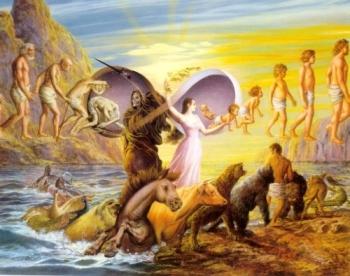Samsara
Back to History 8
Contents
Definition
(In Sanskrit: Literally 'wandering together') The wheel of suffering and rebirth (Manual 15). [1]
Cycle of endless death and reincarnation (Manual 7). [2]
Samsara is represented by Shiva the Destroyer holding a skull that represents samsara, the cycle of life, death and rebirth. [3]
Our souls experience a monotonous cycle of births and deaths.
When the body no longer serves us, our soul gets a new body.
This can be seen as similar to discarding old clothes and getting new ones.
Hinduism
Impact on Daily Life
Moksha was divine liberation for the Hindus. To be united with the universe and all being was the main goal. Moksha was the way to escape the endless cycle of samsara. Therefore, Hindus strived for enlightenment throughout their whole lives. In order to achieve escape from samsara, Hindus followed the five great duties. [5]
Knowledge (study and pray)
Nature (protect)
Ancestors (respect)
Towards society (serve others)
Towards animals (protect and feed)
Thus many Hindus traversed India to accomplish these great duties (Dharma) and escape from the endless life and death cycle of samsara. [6]
 Moksha
Moksha
Legitimization of Authority
The endless cycle of life and death was the main legitimization of authority in India in the Vedic period around 500 B.C.E. Those with good karmic debt would go through samsara and be reborn into a higher living standard. The people of the upper class would justify their position by claiming they had done good deeds in previous lives, and the lower class could not complain about their position as they had placed themselves into that position in their previous life. However, those in different classes would not disrespect each other because they understood the reason they were so lowly was because they had to fulfill their karmic debt and sacred Dharma, duty. [7]

Buddhism
Nirvana
Nirvana was merely escape from samsara, and unlike Hinduism, those who achieved enlightenment did not become one with god and the universe, they just simply escaped from the endless cycle. Still this was a worthy goal, and Buddhists strive to achieve Nirvana.
They did this by following the Four Noble truths
Life is suffering
Desire causes suffering
End desire, end suffering
Follow the Eight-Fold Path
By doing these things and learning them by living a simple life without desire, Buddhists were able to achieve enlightenment and escape samsara.
The Wheel of Life
For more on Samsara: http://hinduism.iskcon.org/concepts/102.htm
A VERY In-Depth explanation of Reincarnation (Samsara) in Buddhism: http://www.buddhanet.net/e-learning/reincarnation.htm
Sources
</references>
Michael Huang
Cite error: <ref> tags exist, but no <references/> tag was found
